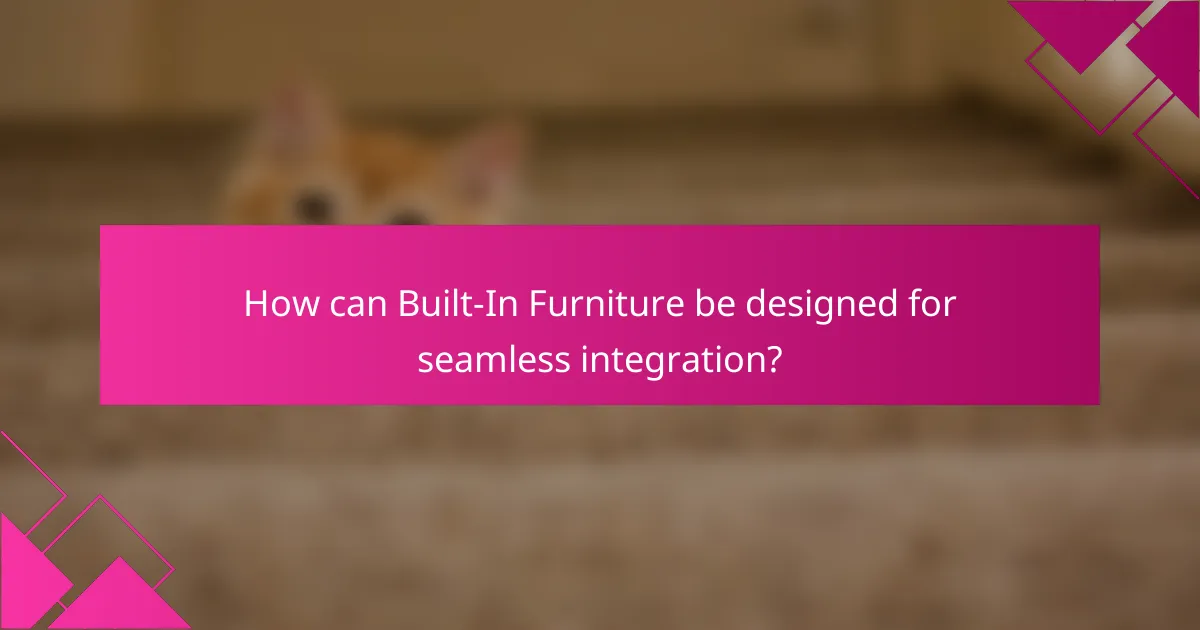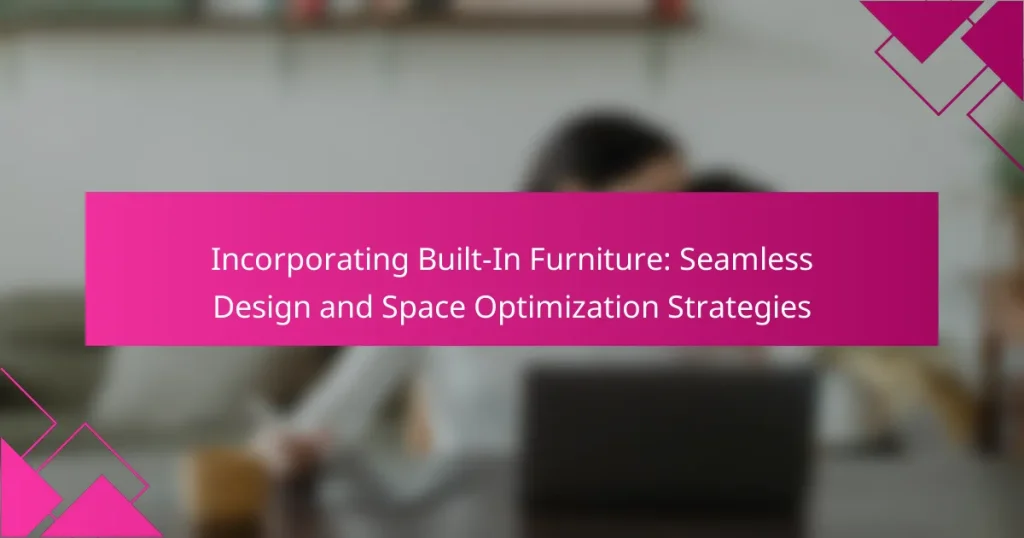Built-in furniture is custom-made furniture designed to integrate seamlessly into the architecture of a space, enhancing both functionality and aesthetics. This type of furniture includes items such as shelves, cabinets, and benches, tailored to specific dimensions and styles of the surrounding area. Key strategies for incorporating built-in furniture involve assessing the space, determining its function, selecting compatible materials, and ensuring cohesive design elements. Additionally, the integration of lighting and modular designs can further optimize space and adapt to various settings, creating a harmonious living environment. The article will explore these strategies in detail, providing insights into effective planning and execution for successful built-in furniture installation.

What is Built-In Furniture?
Built-in furniture refers to custom-made furniture that is integrated into the architecture of a space. This type of furniture is designed to fit seamlessly within walls, corners, or other architectural features. Built-in furniture often includes items like shelves, cabinets, and benches. It is typically constructed to match the design and materials of the surrounding area. This integration maximizes space efficiency and can enhance the aesthetic appeal of a room. Built-in furniture is often used in kitchens, living rooms, and home offices. Its custom nature allows for unique designs tailored to specific needs and preferences.
How does Built-In Furniture differ from traditional furniture?
Built-in furniture is integrated into the architecture of a space, while traditional furniture is standalone. Built-in furniture maximizes space efficiency by utilizing wall space and corners. Traditional furniture often requires additional floor space and can be moved. Built-in options are custom-made to fit specific dimensions, enhancing functionality. Traditional pieces are generally mass-produced and may not fit perfectly in every space. Built-in furniture can offer a cohesive aesthetic, blending with the room’s design. In contrast, traditional furniture can introduce varied styles and may not match the surrounding decor.
What are the key characteristics of Built-In Furniture?
Built-in furniture is custom-designed to fit specific spaces. It maximizes available space by utilizing wall areas and corners. This type of furniture often includes features like shelves, cabinets, and seating. Built-in furniture is typically more durable than freestanding options because it is anchored to the structure. It offers a seamless look, blending with the room’s architecture. Built-in designs can enhance functionality and organization. They are often tailored to individual needs and preferences. This customization can lead to improved aesthetics and increased property value.
Why is Built-In Furniture considered a space-saving solution?
Built-in furniture is considered a space-saving solution because it maximizes usable space within a room. This type of furniture is designed to fit seamlessly into existing structures, such as walls and corners. By utilizing vertical space, built-in options reduce the need for freestanding furniture. They can also provide storage without occupying additional floor area. For example, built-in shelves can be installed above furniture, freeing up ground space. Additionally, built-in furniture often eliminates wasted space that occurs with traditional furniture arrangements. This efficient design approach allows for more open areas and easier movement within a room. Overall, built-in furniture effectively integrates functionality with aesthetics, making it ideal for optimizing limited spaces.
What are the advantages of incorporating Built-In Furniture?
Incorporating built-in furniture offers several advantages. It maximizes space efficiency, allowing for better use of available areas. Built-in furniture can be customized to fit specific dimensions and styles, enhancing aesthetic appeal. This type of furniture often provides additional storage solutions, helping to reduce clutter. Built-in options are typically more durable and can be designed to match existing decor seamlessly. They can also increase the overall value of a property by providing a polished look. The integration of built-in furniture can lead to a more organized living environment, promoting functionality.
How does Built-In Furniture enhance the aesthetic appeal of a space?
Built-in furniture enhances the aesthetic appeal of a space by creating a cohesive and streamlined look. This type of furniture is designed to fit seamlessly within the architecture of the room. It eliminates clutter by providing integrated storage solutions. Built-in furniture can also highlight architectural features, such as windows or alcoves. Customization options allow for unique designs that reflect personal style. The use of high-quality materials further elevates the visual impact. Additionally, built-in furniture can maximize space efficiency, making rooms feel more open and inviting. Overall, it contributes to a polished and sophisticated interior design.
What are the functional benefits of Built-In Furniture in small spaces?
Built-in furniture provides several functional benefits in small spaces. It maximizes available square footage by utilizing wall space efficiently. This type of furniture often includes storage solutions, which help reduce clutter. Built-in designs can be customized to fit specific dimensions and styles. They seamlessly integrate with existing architecture, enhancing the overall aesthetic. Additionally, built-in furniture can serve multiple purposes, such as seating and storage combined. Research shows that effective space utilization can improve the functionality of small living areas. Studies indicate that homes with built-in solutions often feel more spacious and organized.

How can Built-In Furniture be designed for seamless integration?
Built-in furniture can be designed for seamless integration by ensuring it matches the surrounding architecture and décor. This involves selecting materials and finishes that complement existing elements. Customization is key; furniture should be tailored to fit specific spaces and dimensions. Incorporating built-in lighting enhances functionality and visual appeal. Additionally, using modular designs allows for flexibility and adaptability in various settings. A cohesive color palette further unifies the space, making the furniture blend effortlessly. Research indicates that seamless integration improves both aesthetics and functionality, creating a harmonious living environment.
What design principles should be considered for Built-In Furniture?
Built-in furniture should be designed with functionality, aesthetics, and integration in mind. Functionality ensures the furniture meets the specific needs of the space and users. Aesthetics involve aligning the furniture design with the overall style of the room. Integration requires seamless blending with architectural elements.
Proportions must be considered for visual balance and usability. Material selection impacts durability and appearance. Accessibility is crucial for user convenience. Customization allows for personalized solutions that fit unique spaces.
These principles enhance the effectiveness of built-in furniture, creating harmonious and efficient environments.
How can color and materials influence the integration of Built-In Furniture?
Color and materials significantly influence the integration of built-in furniture. They affect the overall aesthetic and functionality of a space. Light colors can make a room feel larger and more open. Dark colors can create a cozy, intimate atmosphere. The choice of materials impacts durability and maintenance. Natural materials like wood add warmth and texture. Synthetic materials may offer modernity and ease of cleaning. Cohesive color schemes help built-in furniture blend seamlessly with existing decor. Contrasting colors can make built-ins a focal point in a room. Research indicates that color psychology affects mood and perception of space. Therefore, thoughtful selection of color and materials enhances both design and usability.
What role does architectural style play in Built-In Furniture design?
Architectural style significantly influences built-in furniture design. It determines the overall aesthetics and functionality of the furniture. For instance, modern architectural styles favor clean lines and minimalism. This leads to built-in furniture that is sleek and unobtrusive. In contrast, traditional styles may incorporate ornate details and rich materials. This results in built-in furniture that enhances classic architectural elements. Additionally, the scale and proportion of built-in furniture must align with the architectural features. This ensures harmony between the furniture and the surrounding space. Ultimately, the architectural style serves as a guiding framework for the design and integration of built-in furniture.
How can Built-In Furniture optimize space in various settings?
Built-in furniture optimizes space by utilizing wall areas and corners efficiently. This type of furniture is designed to fit seamlessly into a room’s architecture. It minimizes the footprint of individual pieces, allowing for more open floor space. Built-in shelves can provide storage without occupying additional room area. Custom designs can cater to specific dimensions, making the most of available space. In small homes, built-in benches can double as storage. In offices, built-in desks can create organized workspaces without clutter. Studies show that built-in furniture can increase usable space by up to 30%.
What are effective strategies for using Built-In Furniture in living areas?
Effective strategies for using built-in furniture in living areas include maximizing space efficiency and enhancing aesthetics. Built-in furniture can be custom-designed to fit specific dimensions and needs. This allows for optimal use of available space, particularly in smaller living areas. Integrating storage solutions within built-ins helps reduce clutter while maintaining a clean look. Utilizing built-in seating can create cozy nooks and encourage social interaction. Additionally, choosing materials and finishes that complement the overall design theme enhances visual appeal. Built-in furniture can also serve as focal points, such as a media center or bookshelf, adding character to the space. Overall, these strategies contribute to a functional and stylish living area.
How can Built-In Furniture be utilized in kitchens and bathrooms for better functionality?
Built-in furniture can enhance functionality in kitchens and bathrooms by maximizing space and providing organized storage solutions. In kitchens, built-in cabinets can be designed to fit specific appliances, creating a seamless look and efficient workflow. This allows for more counter space and reduces clutter. In bathrooms, built-in vanities can incorporate sinks and storage, optimizing limited square footage. Additionally, built-in shelves can hold toiletries and towels, keeping the area tidy. Customization options enable homeowners to tailor these solutions to their specific needs, ensuring practicality and style. Studies show that well-designed built-in furniture can increase usability and improve overall satisfaction in these spaces.

What are the steps to incorporate Built-In Furniture into a space?
Identify the space where built-in furniture will be incorporated. Assess the dimensions and layout of the area. Determine the function of the built-in furniture, such as storage or seating. Design the furniture to complement the existing decor and architecture. Select materials that are durable and match the aesthetic of the room. Create detailed plans or sketches to visualize the final product. Consult with professionals if necessary for installation. Execute the installation carefully to ensure stability and functionality.
How do you assess a space for Built-In Furniture opportunities?
To assess a space for built-in furniture opportunities, first, evaluate the dimensions of the area. Measure the length, width, and height to understand spatial constraints. Next, identify existing features such as windows, doors, and electrical outlets. These elements influence the design and placement of built-in units.
Consider the functionality of the space. Determine how the built-in furniture will enhance usability. Analyze traffic flow and accessibility to ensure the furniture does not obstruct movement.
Examine the overall style and aesthetic of the room. Built-in furniture should complement the existing décor. Take note of color schemes and materials for a cohesive look.
Lastly, assess storage needs. Identify items that require storage solutions. Built-in furniture can maximize space while providing practical storage options.
What measurements and planning are essential before installation?
Essential measurements and planning before installation include assessing available space dimensions. Accurate measurements of height, width, and depth are crucial for fitting built-in furniture. Additionally, consider doorways, windows, and ceiling heights to ensure proper installation. Planning should also involve identifying electrical outlets and plumbing locations if applicable. Creating a detailed floor plan can help visualize the arrangement. Furthermore, account for any potential obstructions in the space. Ensuring these factors are addressed leads to a successful installation process.
How can you ensure that Built-In Furniture meets your specific needs?
To ensure that built-in furniture meets your specific needs, conduct a thorough assessment of your space and requirements. Begin by measuring the dimensions of the area where the furniture will be installed. This ensures a precise fit and optimal use of space. Next, identify your functional needs, such as storage requirements or seating capacity. This helps in designing furniture that serves your lifestyle effectively.
Consider your aesthetic preferences, including style, color, and materials. This alignment with your taste enhances the overall design. Collaborate with a professional designer who specializes in built-in furniture. Their expertise can guide you in creating custom solutions that fit your specifications.
Review examples of previous projects by the designer to ensure their style matches your vision. Lastly, request a prototype or detailed drawings before finalizing the design. This allows you to visualize the furniture in your space and make necessary adjustments.
What are the common challenges when incorporating Built-In Furniture?
Common challenges when incorporating built-in furniture include design limitations, cost considerations, and installation difficulties. Design limitations arise from the need for precise measurements and compatibility with existing structures. Cost considerations can be significant, as custom-built options often exceed standard furniture prices. Installation difficulties may occur due to the complexity of fitting built-in pieces into specific spaces. Additionally, ensuring proper functionality and access to utilities can complicate the process. These challenges require careful planning and professional assistance to achieve successful integration.
How can you overcome design limitations in existing spaces?
To overcome design limitations in existing spaces, utilize built-in furniture solutions. Built-in furniture maximizes available space and enhances functionality. This approach allows for customized designs that fit specific dimensions and styles. For example, built-in shelves can utilize vertical space effectively. Additionally, modular built-ins can adapt to changing needs over time. Implementing flexible layouts can also improve flow and accessibility. Research indicates that tailored built-in solutions can increase space utilization by up to 30%. Employing these strategies leads to more efficient and aesthetically pleasing environments.
What are the potential costs associated with Built-In Furniture projects?
The potential costs associated with Built-In Furniture projects vary widely based on multiple factors. Custom built-in furniture typically ranges from $1,000 to $10,000 or more. Materials significantly impact costs; high-quality wood and finishes increase the budget. Labor costs also contribute, averaging $50 to $150 per hour for skilled carpenters. Design complexity can raise expenses; intricate designs require more time and expertise. Additionally, installation fees may apply, often ranging from $200 to $1,000. Overall, project scope and customization level dictate the final cost.
What are the best practices for maintaining Built-In Furniture?
Regular cleaning is essential for maintaining built-in furniture. Use a soft, damp cloth to wipe surfaces weekly. Avoid harsh chemicals that can damage finishes. Inspect joints and hinges for any signs of wear or damage. Tighten screws and fittings as needed to ensure stability. Apply wood polish or conditioner periodically to prevent drying. Keep the furniture away from direct sunlight to avoid fading. Use coasters and placemats to protect surfaces from heat and moisture. Following these practices can extend the lifespan of built-in furniture significantly.
How can regular maintenance extend the life of Built-In Furniture?
Regular maintenance can significantly extend the life of built-in furniture. Routine cleaning prevents dust and grime buildup that can damage surfaces. Regular inspections allow for early detection of issues like loose hinges or worn-out finishes. Applying protective coatings can shield materials from wear and tear. Tightening screws and hardware ensures structural integrity. Regularly conditioning wood surfaces maintains their appearance and prevents cracking. Following manufacturer guidelines for care can enhance durability. Studies show that well-maintained furniture can last decades longer than neglected pieces.
What cleaning techniques are recommended for different materials used in Built-In Furniture?
Wooden built-in furniture should be cleaned with a damp cloth and a mild soap solution. Avoid excessive water, as it can damage the wood. For lacquered surfaces, use a soft microfiber cloth to prevent scratches. Glass components can be cleaned with a glass cleaner or a vinegar-water solution for streak-free shine. Upholstered furniture requires vacuuming and spot cleaning with appropriate fabric cleaners. Metal surfaces should be wiped with a damp cloth and dried immediately to prevent rust. Regular dusting and maintenance prolong the life of built-in furniture across all materials.
Built-in furniture is custom-made furniture that integrates seamlessly into the architecture of a space, maximizing space efficiency and enhancing aesthetics. This article explores the differences between built-in and traditional furniture, highlighting the key characteristics, advantages, and functional benefits of built-ins in various settings, including kitchens and bathrooms. It also discusses design principles, color and material influences, and strategies for optimizing space in living areas. Additionally, the article addresses common challenges, costs, maintenance practices, and cleaning techniques associated with built-in furniture, providing comprehensive insights for effective incorporation into any home.


